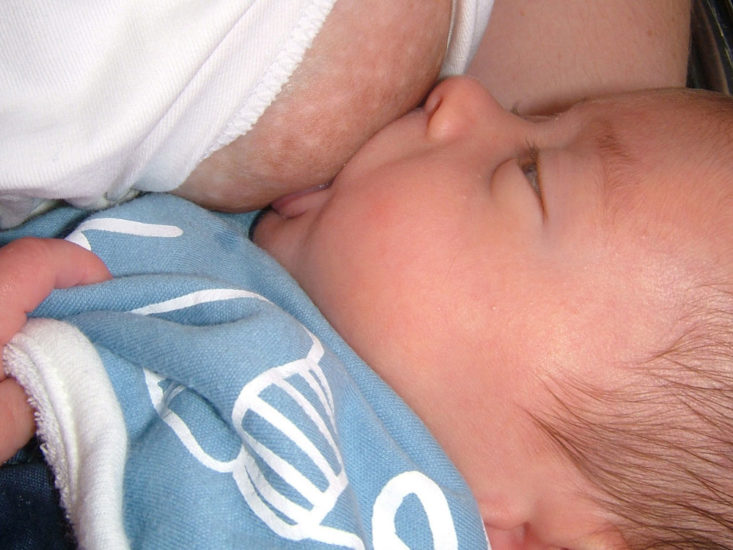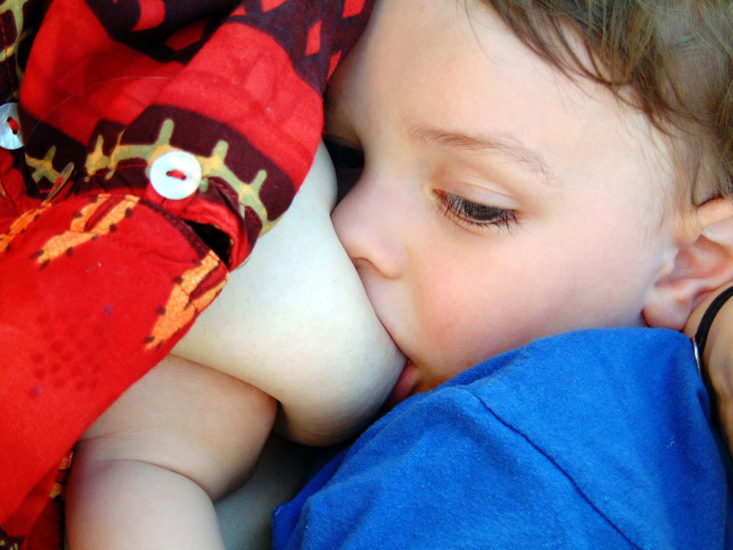Put “lip-tie” into your search engine and you will get plenty of websites claiming it is the cause of breastfeeding difficulties or fussy behaviour. However, not everyone agrees with this view and there is little evidence to support it. Who is right? Is lip-tie anything to worry about? This article discusses what a lip-tie is, whether it affects breastfeeding and answers frequently asked questions.
What are tongue-ties and lip-ties?
Tongue-tie
A tongue-tie describes the situation when the membrane (lingual frenulum) between the underside of the tongue and the floor of the mouth or lower gums is particularly short or tight and restricts the movement of the tongue. Lots of tongues have this connective tissue under the tongue but only a few cause sufficient restriction to the tongue to interfere with breastfeeding. I have written more about tongue-tie in Tongue-Tie and Breastfeeding.
Lip-tie
There is also a membrane (called a labial frenulum, superior labial or maxillary labial frenulum) that connects the underside of the top lip to the gums.1 The term “lip-tie” describes a membrane that restricts the normal movements of the top lip. Confusingly, some people may use lip-tie to refer to the normal presence of a membrane in this location. As with the membrane under the tongue, just because there is a frenulum under the lip, it doesn’t mean there is a problem.234 The upper lip frenulum often changes in appearance as a baby grows and there is confusion about its role and significance (Santa Maria et al, 2017). An article in Global Paediatric Health explains:
the typical versus atypical appearance of this frenulum is not known. Nor is it known whether this frenulum has any functional consequences relating to its appearance or attachment.

What does the top lip do during breastfeeding?
The baby’s top lip rests on the breast during breastfeeding in a neutral or very slightly everted position and makes a seal around the breast.567 The top lip doesn’t need to gape away from the gum or flare out like the lips of a fish. The baby’s top lip shouldn’t need to move up and down, grip tightly to the breast nor curl in. If the top lip flares out or there is a pronounced crease between the lip and nose (called a nasolabial crease) this could indicate baby is in a shallow latch (not much breast tissue in baby’s mouth) or positioned too high at the breast with more of the top lip over the breast than the bottom lip below it.
Do lip-ties affect breastfeeding?
Given the role of the top lip during breastfeeding—to rest on the breast and make a seal—the position of the frenulum under the top lip is unlikely to be a cause of breastfeeding problems for the majority of mothers and babies. Cathy Watson Genna discusses that a very tight lip frenulum could produce a sucking blister on the mucosal surface (underside) of the upper lip which might make it more difficult for a baby to stay attached (Watson Genna, 2017). However there can be other causes of a sucking blister from simple positioning to the use of certain bottle teats.
No evidence
There are many reasons why breastfeeding might hurt, why a mother might have low milk supply or why a baby might not gain weight or have wind but currently there is no evidence or agreement that a “lip-tie” is an important factor in any of these.891011
Faulty rationale?
The idea that lip-ties can influence latch seems to depend on the belief that the upper lip must be turned out, or flanged, during breastfeeding. This assertion is readily adopted by fee charging practitioners. However, breastfeeding specialists and lactation consultants know that while it is desirable for the lower lip to be turned out against the breast, this is not necessary or desirable in the upper lip. It may work for some babies of course, but it isn’t a goal or rule to strive for.
What if my baby’s top lip is rolling in, moving up and down or losing suction during feeding?
There are several reasons to explain why a baby’s top lip might curl in, overly grip the breast, lose suction or be moving excessively and seem to cause pain. Any of these could be confused with “lip-tie” however other explanations include:
- Unstable positioning. If a baby doesn’t feel stable they may try to hold on to the breast with their lips to give them more stability. You may notice your baby has a sucking blister on his top lip if he is using it excessively (Watson Genna, 2017). Adjusting baby’s position so their whole body is supported can help with this and keeping baby closer to the breast can reduce movement and hence friction with each suck.
- Shallow latch. If a baby is in a shallow latch (has mostly nipple in their mouth and not much breast tissue) or has more of the top lip over the breast than the bottom lip is below it, baby’s tongue may not move optimally and the lips may try to compensate. Sometimes a baby’s or mother’s anatomy makes it more difficult to get a deeper latch e.g. a receding chin, pronounced upper lip or a large nipple.
- Adjustments needed. Sometimes a baby will latch with their upper and/or lower lip curled in but simple adjustments can often be made to correct this after the latch. A little breast milk to moisten the latching area may be helpful. Many lower lips can be gently everted with fingertip pressure to the baby’s chin and similarly the upper lip can be encouraged out with a finger if it is rolled in.
- Tongue-tie. If a baby has abnormal tongue movements or a tongue-tie, he may overwork his lips to compensate for poor tongue function.
- High muscle tone. A baby with high muscle tone might have a lot of tension in their lips. Excessive lip tone may be associated with a neurological issue or an injury of the jaws, tongue or facial nerves.12 High lip tone can also be associated with poor positioning or nipple confusion from bottle feeding and might cause nipple damage and affect milk transfer (Walker, 2017).
- Low tone, losing suction. Losing suction at the breast or spilling milk from the lips can be associated with weak lip tone or generalised low muscle tone (hypotonia). This can cause a baby to get quite tired at the breast and take in less milk.13 Other possibilities to consider include underdevelopment of the facial nerve, nerve damage or facial asymmetry.14
- Breathing difficulty, congestion. Difficulty breathing through the nose may cause a baby to let go of the breast in order to breathe through their mouth.
It’s not just about the lips!
If breastfeeding hurts, a breastfeeding specialist can help you with positioning and see Breastfeeding Positions for Newborns, Latching Tips and Why Does Breastfeeding Hurt?
Why is everyone talking about lip-tie?
Worried parents searching for breastfeeding answers on the internet (especially on Facebook) are frequently being told that their babies might have lip-ties. These internet advisors have not seen the baby breastfeeding or taken a medical history. They are usually not medically trained nor breastfeeding specialists. Many are using the term “lip-tie” to refer to a normal upper lip frenulum. Just because there is almost certainly a frenulum under a baby’s top lip, and just because there are health professionals in some countries who are happy to surgically remove it for a price, this does not mean your baby has anything other than normal anatomy. Without a proper assessment by a breastfeeding specialist to check positioning and attachment, there is a risk of unnecessary, painful and expensive procedures being carried out on babies with no benefit to breastfeeding.
The primary justification for these procedures is to facilitate and improve breastfeeding; however, there is little evidence that certain appearances of the labial frenula have any bearing on latching or feeding.
What about parents who say having their babies lip-tie cut helped pain/wind/weight gain?
Some mothers feel removal of the labial frenulum helped feeding in some way and become fierce advocates for the procedure. Bear in mind the baby may have had both a tongue-tie and the lip frenulum divided at the same time. If breastfeeding comfort improved after both procedures it was most likely due to division of the tongue-tie. In some cases, the procedure might help a baby compensate for the real underlying issue. Sarah Oakley, IBCLC explains:
The added ability to fully flange the top lip will allow a baby to compensate for continued poor positioning or tongue function issues. But of course this is treating a symptom and not the underlying cause. Improving positioning, tongue –tie division, tongue exercises and suck training to promote effective tongue mobility would be more appropriate.
Conversely, if baby had been overworking the upper lip, a painful wound on the inside of the upper lip might prevent him using that compensation after the procedure.
Pamela Douglas says that any studies claiming benefits from upper lip tie division are biased or flawed.15
Can lip-tie cause tooth decay?
If it is difficult to clean a baby’s front teeth due to a frenulum that can trap food or a frenulum that prevents the top lip from being lifted to clean the teeth, this could be associated with dental caries. However, as the labial frenulum changes over time, it may not be a problem by the time your baby has a full set of teeth (Santa Maria et al, 2017). Careful attention can be paid to cleaning the front teeth and any concerns can be discussed with your child’s dentist if problems arise. The Australian Dental Association says there is not enough evidence to support the idea that a short or tight upper lip frenulum could increase the risk of tooth decay (ADA, 2020).
Can lip-tie cause a gap in the front teeth?
The Australian Collaboration for Infant Oral Research (ACIOR) says that the presence of a prominent midline lip frenulum does not predict tooth spacing later.16 Nagveni et al explain:
Labial frenum is a dynamic and often changeable structure and is subject to variation in shape, size, and position during the different stages of growth and development. During growth, it tends to decrease in size and lose clinical importance. In young children, the frenum is generally wide and thick, and during growth it becomes thin and small
The Australian Dental Association agrees there is not enough evidence to support the idea that releasing an upper lip frenulum could prevent a gap between the top two teeth or help with other orthodontic issues (ADA, 2020).
What is the treatment for lip-tie?
The labial frenulum is removed by laser or via cutting in a surgical procedure. Potential risks include:
- Haemorrhage if scissors frenotomy (mitigated by use of laser)
- Unnecessary pain and distress
- Wound infection
- Oral aversion resulting in worsened feeding problems in infant with pre-existing breastfeeding or feeding problems
- Underlying feeding/breastfeeding problems remain unidentified and unmanaged
- Worsened diastema of upper incisors in later childhood due to scarring
Wound care
Some practitioners tell parents to regularly stretch the wound to prevent a frenulum from reforming. This is painful for babies and upsetting for parents whether under the tongue or under the lip.17 A consensus statement from a range of health professions was coordinated by the Australian Dental Association. They state there is no scientific evidence to support stretching surgical wounds and that this kind of “active wound care” prolongs healing and increases the risk of infection and scarring (ADA, 2020).
Has my lactation consultant missed my baby’s lip-tie?
Your lactation consultant will be able to gauge what your baby is doing with his lips and tongue by watching a breastfeed, not just because of the appearance under your baby’s lip. They will spend time talking to you about your medical history and breastfeeding experience. Your lactation consultant will make suggestions to improve positioning or know when to refer you back to your GP, paediatrician or tongue-tie practitioner. If you’re still finding breastfeeding painful or difficult, get back in touch with your breastfeeding specialist and let them know. The more you can tell them, the better they will be able to help you.
What do independent experts say?
The Association of Tongue Tie Practitioners (ATP) in UK say:
Currently there is no published evidence supporting a link between breastfeeding issues and lip tie.
The National Institute for Health and Care Excellence (NICE) have not issued any guidance on this issue and therefore training is not available in the UK in lip tie division for practitioners.
This situation may change in the future if new research and evidence influences best practice guidelines. Currently nurse/midwife tongue-tie practitioners working in the UK cannot offer lip tie division as the Nursing and Midwifery Council’s Code of Conduct states that nurses, midwives and health visitors must ‘deliver care based on the best available evidence or best practice‘ and ensure any advice given is evidence based if suggesting healthcare products or services.
The Australian Collaboration for Infant Oral Research says:
We recommend no intervention, as maxillary labial and buccal frena [“cheek ties”] are normal anatomic variants and do not ‘tie down the upper lip’ to impact on breastfeeding or feeding function. Unnecessary anxiety is created for parents when a normal anatomic variant is labelled as a ‘tie’.
What do the books say?
Many breastfeeding reference books do not contain sections about lip-tie suggesting it is a new theory to explain breastfeeding difficulties and that there is a lack of robust evidence associating it with breastfeeding issues. The 4th edition of Breastfeeding Management for the Clinician goes along with the idea that the upper lip must flange out and associates poor latch with lip-tie.
The Breastfeeding Atlas, 7e explains that the labial frenulum is normal anatomy, gives stability to the upper lip and has many variations in appearance. The authors say:
In conclusion, no short- or long-term outcome studies are currently available to document either benefit or unintended consequences of releasing the upper labial frenulum of infants experiencing breastfeeding difficulties.
Summary
A frenulum under the top lip is normal anatomy providing stability to the upper lip. It changes over time tending to become thinner and smaller as baby grows. There is insufficient evidence that certain appearances of this frenulum can cause difficulties breastfeeding. The upper lip plays a relatively minor role during breastfeeding. Despite this, it has become fashionable amongst some parents to blame “lip-tie” on all manner of breastfeeding issues, aggressively so in some cases. Parents are being urged by other parents to have their baby’s lip frenulum removed. The rationale upon which the argument is based—that the upper lip must flange during breastfeeding—is not supported by lactation consultants who work with breastfeeding mothers every day. There is no long term research on the implications of removing the labial frenulum in a newborn. Parents should be aware that breastfeeding forums on social media should not be a substitute for good face-to-face support with a breastfeeding specialist.

